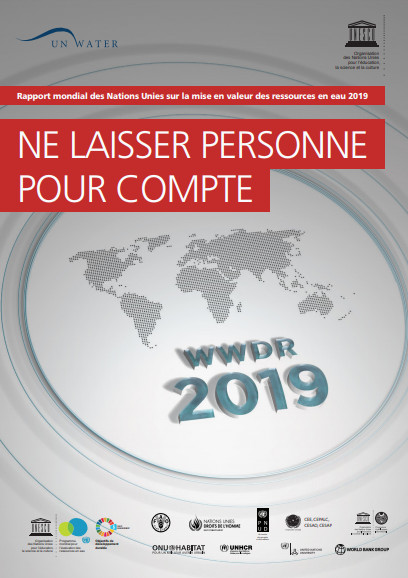Rapport mondial des Nations Unies sur la mise en valeur des ressources en eau : Ne laisser personne pour compte
 |
The United Nations world water development report 2019: leaving no one behind WWDR 2019
Informe Mundial de las Naciones Unidas sobre el Desarrollo de los Recursos Hídricos 2019:no dejar a nadie atrás
rapport coll. WWDR Rapport mondial des Nations Unies sur la mise en valeur des ressources en eau n° 2019 Mar 2019 ; 214 pages
Ed. Un-Water - New York Unesco Editions - Paris
Téléchargeable sous format: PdF
Téléchargeable chez l'éditeur
 Résumé
Résumé:
Résumé
Résumé:L'édition 2019 du Rapport mondial sur la mise en valeur des ressources en eau (WWDR 2019) intitulée « Ne laisser personne pour compte » vise à informer les décideurs politiques, de la communauté de l'eau et au delà, sur l'amélioration de la gestion des ressources en eau et de l'accès aux services d'approvisionnement en eau et d'assainissement, condition sinequanone pour lutter contre la pauvreté et contre les inégalités sociales et économiques. Abstract:
The Report, Leaving no one behind, demonstrates how improvements in water resources management and access to water supply and sanitation services are essential to addressing various social and economic inequities, such that ‘no one is left behind’ when it comes to enjoying the multiple benefits and opportunities that water provides. Contents:
Executive summary 1
Introduction 11
Section 1 – The state of the world’s water resources 13
Section 2 – Water supply, sanitation and hygiene 18
Section 3 – Socio-economic development indicators
Chapter 1 – The human rights to water and sanitation and the 2030 Agenda for Sustainable Development 34
1.1 Introduction 35
1.2 The human rights to water and sanitation 36
1.3 Groups and individuals ‘left behind’ in terms of access to water and sanitation 38
1.4 Human rights-based approach to integrated water resources management (IWRM) 41
1.5 Links between the human rights to water and sanitation and other human rights
Chapter 2 – Physical and environmental dimensions 44
2.1 Water-provisioning systems 45
2.2 Sanitation 53
2.3 Disaster risk reduction 56
2.4 Conclusions 57
Chapter 3 Social dimensions 58
3.1 Introduction 59
3.2 Impediments to implementing the rights to water and sanitation 60
3.3 Inequalities related to finance, infrastructure and beyond 65
3.4 Supporting the implementation of the human rights to water and sanitation
Chapter 4 – Political, legal and institutional dimensions 72
4.1 Introduction 73
4.2 Policy, politics and processes 74
4.3 Walking the talk: Implementing plans and policies 78
Chapter 5 – Economic dimensions of WASH services 84
5.1 Introduction 85
5.2 Providing WASH to vulnerable and disadvantaged groups: A cost–benefit analysis 86
5.3 Affordability 87
5.4 Increasing efficiency and reducing unit costs 89
5.5 Designing subsidies and tariffs 90
5.6 Funding and financing: Mobilizing commercial sources of investment 92
5.7 Conclusions 95
Chapter 6 – Cities, urbanization and informal settlements 96
6.1 Defining who are left behind in urban settings 97
6.2 Challenges of monitoring inequalities in service 98
6.3 Mapping and data collection in informal settlements 99
6.4 Integrated urban planning and community engagement 100
6.5 Costs of service provision in high-density low-income urban settlements 101
6.6 Attracting sustainable investment at the local level 102
6.7 Financing WASH in urban settings 103
6.8 Centralized vs. decentralized urban water supply and sanitation systems 103
6.9 Conclusions and policy recommendations
Chapter 7 – Rural poverty 106
7.1 Introduction: Three paradoxes to better understand rural poverty and water 107
7.2 Emerging challenges 109
7.3 Promoting pro-poor multisectoral policies
Chapter 8 – Refugees and forced displacement crises 115
8.1 Refugees and forced displacement: A global challenge 117
8.2 Marginalization of the displaced: Main drivers 119
8.3 Providing displaced people with access to water and sanitation 121
8.4 Fragile states and states in fragile situations
Chapter 9 – Regional perspectives 128
9.1 The Arab region 129
9.2 Asia and the Pacific 132
9.3 Europe and North America 135
9.4 Latin American and the Caribbean 138
9.5 Sub-Saharan Africa 142
Chapter 10 – Strategies and response options for inclusive development 146
10.1 Introduction 147
10.2 Enhancing water supply and improving accessibility 147
10.3 Addressing the investment gap 148
10.4 Knowledge and capacity development 150
10.5 Governance 151
10.6 Roles and responsibilities in realizing the human rights to water and sanitation 153
Chapter 11 – The way forward 156
Mot clef: |
Editeurs/Diffuseurs: |
|
Un-Water - New York - Etats Unis |
Unesco Editions - Paris |
En cas de lien brisé, nous le mentionner à communication@pseau.org